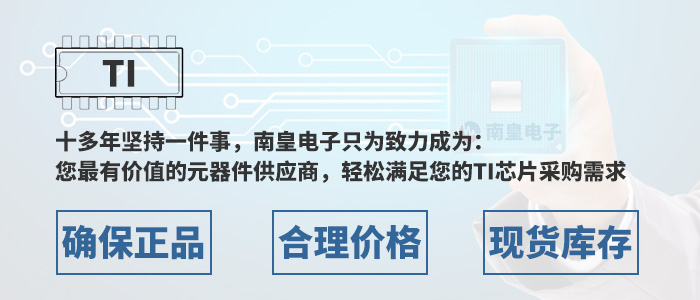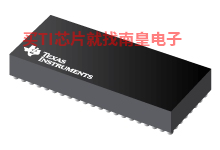
- 制造厂商:TI
- 产品类别:时钟和计时
- 技术类目:时钟缓冲器
- 功能描述:具有地址奇偶校验测试的 28 位至 56 位寄存缓冲器
- 点击这里打开及下载74SSTUB32868的技术文档资料
- TI代理渠道,提供当日发货、严格的质量标准,满足您的目标价格

This 28-bit 1:2 configurable registered buffer is designed for 1.7-V to 1.9-V VCC operation. One device per DIMM is required to drive up to 18 SDRAM loads or two devices per DIMM are required to drive up to 36 SDRAM loads.
All inputs are SSTL_18, except the chip-select gate-enable (CSGEN), control (C), and reset (RESET) inputs, which are LVCMOS. All outputs are edge-controlled circuits optimized for unterminated DIMM loads, and meet SSTL_18 specifications, except the open-drain error (QERR) output.
The 74SSTUB32868 operates from a differential clock (CLK and CLK). Data are registered at the crossing of CLK going high and CLK going low.
The 74SSTUB32868 accepts a parity bit from the memory controller on the parity bit (PAR_IN) input, compares it with the data received on the DIMM-independent D-inputs (D1-D5, D7, D9-D12, D17-D28 when C = 0; or D1-D12, D17-D20, D22, D24-D28 when C = 1) and indicates whether a parity error has occurred on the open-drain QERR pin (active low). The convention is even parity, i.e., valid parity is defined as an even number of ones across the DIMM-independent data inputs combined with the parity input bit. To calculate parity, all DIMM-independent D-inputs must be tied to a known logic state.
The 74SSTUB32868 includes a parity checking function. Parity, which arrives one cycle after the data input to which it applies, is checked on the PAR_IN input of the device. Two clock cycles after the data are registered, the corresponding QERR signal is generated.
If an error occurs and the QERR output is driven low, it stays latched low for a minimum of two clock cycles or until RESET is driven low. If two or more consecutive parity errors occur, the QERR output is driven low and latched low for a clock duration equal to the parity error duration or until RESET is driven low. If a parity error occurs on the clock cycle before the device enters the low-power mode (LPM) and the QERR output is driven low, it stays latched low for the LPM duration plus two clock cycles or until RESET is driven low. The DIMM-dependent signals (DCKE0, DCKE1, DODT0, DODT1, DCS0 and DCS1) are not included in the parity check computation.
The C input controls the pinout configuration from register-A configuration (when low) to register-B configuration (when high). The C input should not be switched during normal operation. It should be hard-wired to a valid low or high level to configure the register in the desired mode.
In the DDR2 RDIMM application, RESET is specified to be completely asynchronous with respect to CLK and CLK. Therefore, no timing relationship can be ensured between the two. When entering reset, the register is cleared and the data outputs is driven low quickly, relative to the time to disable the differential input receivers. However, when coming out of reset, the register becomes active quickly, relative to the time to enable the differential input receivers. As long as the data inputs are low, and the clock is stable during the time from the low-to-high transition of RESET until the input receivers are fully enabled, the design of the 74SSTUB32868 must ensure that the outputs remain low, thus ensuring no glitches on the output.
To ensure defined outputs from the register before a stable clock has been supplied, RESET must be held in the low state during power up.
The device supports low-power standby operation. When RESET is low, the differential input receivers are disabled, and undriven (floating) data, clock, and reference voltage (VREF) inputs are allowed. In addition, when RESET is low, all registers are reset and all outputs are forced low except QERR. The LVCMOS RESET and C inputs always must be held at a valid logic high or low level.
The device also supports low-power active operation by monitoring both system chip select (DCS0 and DCS1) and CSGEN inputs and will gate the Qn outputs from changing states when CSGEN, DCS0, and DCS1 inputs are high. If CSGEN, DCS0 or DCS1 input is low, the Qn outputs function normally. Also, if both DCS0 and DCS1 inputs are high, the device will gate the QERR output from changing states. If either DCS0 or DCS1 is low, the QERR output functions normally. The RESET input has priority over the DCS0 and DCS1 control and when driven low forces the Qn outputs low, and the QERR output high. If the chip-select control functionality is not desired, then the CSGEN input can be hard-wired to ground, in which case, the setup-time requirement for DCS0 and DCS1 would be the same as for the other D data inputs. To control the low-power mode with DCS0 and DCS1 only, then the CSGEN input should be pulled up to VCC through a pullup resistor.
The two VREF pins (A5 and AB5) are connected together internally by approximately 150  . However, it is necessary to connect only one of the two VREF pins to the external VREF power supply. An unused VREF pin should be terminated with a VREF coupling capacitor.
. However, it is necessary to connect only one of the two VREF pins to the external VREF power supply. An unused VREF pin should be terminated with a VREF coupling capacitor.
- Member of the Texas Instruments Widebus+? Family
- Pinout Optimizes DDR2 DIMM PCB Layout
- 1-to-2 Outputs Supports Stacked DDR2 DIMMs
- One Device Per DIMM Required
- Chip-Select Inputs Gate the Data Outputs from Changing State and Minimizes System Power Consumption
- Output Edge-Control Circuitry Minimizes Switching Noise in an Unterminated Line
- Supports SSTL_18 Data Inputs
- Differential Clock (CLK and CLK) Inputs
- Supports LVCMOS Switching Levels on the Chip-Select Gate-Enable, Control, and RESET Inputs
- Checks Parity on DIMM-Independent Data Inputs
- Supports Industrial Temperature Range (-40°C to 85°C)
- RESET Input Disables Differential Input Receivers, Resets All Registers, and Forces All Outputs Low, Except QERR
- APPLICATIONS
- DDR2 registered DIMM
Widebus+ is a trademark of Texas Instruments.
- Function
- Memory interface
- Output frequency (Max) (MHz)
- 410
- Number of outputs
- 56
- Output supply voltage (V)
- 1.8
- Core supply voltage (V)
- 1.8
- Features
- DDR2 register
- Operating temperature range (C)
- -40 to 85
- Rating
- Catalog
- Output type
- SSTL-18
- Input type
- SSTL-18
74SSTUB32868的完整型号有:74SSTUB32868ZRHR,以下是这些产品的关键参数及官网采购报价:
74SSTUB32868ZRHR,工作温度:-40 to 85,封装:NFBGA (ZRH)-176,包装数量MPQ:1000个,MSL 等级/回流焊峰值温度:Level-3-260C-168 HR,引脚镀层/焊球材料:SNAGCU,TI官网74SSTUB32868ZRHR的批量USD价格:7.667(1000+)

PSPICE-FOR-TI — 适用于 TI 设计和模拟工具的 PSpice
PSpice for TI 可提供帮助评估模拟电路功能的设计和仿真环境。此功能齐全的设计和仿真套件使用 Cadence 的模拟分析引擎。PSpice for TI 可免费使用,包括业内超大的模型库之一,涵盖我们的模拟和电源产品系列以及精选的模拟行为模型。借助?PSpice for TI 的设计和仿真环境及其内置的模型库,您可对复杂的混合信号设计进行仿真。创建完整的终端设备设计和原型解决方案,然后再进行布局和制造,可缩短产品上市时间并降低开发成本。
在?PSpice for TI 设计和仿真工具中,您可以搜索 TI (...)



